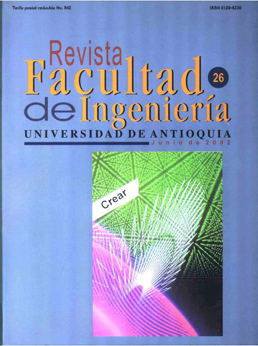Visión general sobre redes ópticas
DOI:
https://doi.org/10.17533/udea.redin.326376Palabras clave:
Redes completamente ópticas, multiplexación por división de longitud de onda, ecaminamiento y asignación de longitudes de onda, conmutación de circuitos, conmutación de paquetes, topologías, arquitecturas, MPλS.Resumen
El propósito de este artículo es proveer una visión general de las redes ópticas, haciendo especial énfasis en las redes DWDM (multiplexación por división de longitud de onda densa) completamente ópticas por sus características de capacidad, transparencia, escalabilidad y modularidad. El presente artículo se desarrollará de la siguiente manera: en primer lugar se mostrarán las ventajas de las redes ópticas para transmisión de información, luego se tratarán algunos aspectos referentes a los servicios, las arquitecturas y topologías de las redes ópticas y finalmente se mostrarán algunas líneas de desarrollo en estas redes.Descargas
Citas
Govind P Agrawal. Fiber Optic Communication Systems. New York: Wiley Interscience Publication. 1999. p. 544.
Charles Brackett. "Dense Wavelength Division Multiplexing Networks: Principles and Applications". En IEEE Journal On Selected Areas In Communications. New York. Vol. 8. No. 6. Agosto, 1990. pp. 948-964. DOI: https://doi.org/10.1109/49.57798
Paul Green. Fiber Optic Network. New Jersey: PrenticeHall. 1993. p. 514.
John M Senior. Optical Fiber Communications: Principles and Practice. New York: Prentice-Hall. 1992. p. 922.
Joseph C Palais. Fiber Optic Communications. 4ª. ed. New Jersey: Prentice-Hall International. 1998. p. 342.
Paul Green. "Progress in Optical Networking". En IEEE Communication Magazine. Vol. 39. No. l. Enero, 2001. pp. 54-61. DOI: https://doi.org/10.1109/35.894377
Paul Green. "Optical Networking Upgrade". En IEEE Journal on Selected Areas in Communications. Vol. 14. No. 5. Junio, 1996. pp. 764-779. DOI: https://doi.org/10.1109/49.510902
S Kawanishi et al. "3 Tbit/s (160 Gbit/s x 19 channel) Transmission by Optical TDM and WDM". En IEEE. Laser and Electro-Optics Society Newsletter. Vol. 13. No. 5. Octubre, 1999. DOI: https://doi.org/10.1049/el:19990576
Rajiv Ramaswami, Kumar N. Sivarajan. Optical networks. A practical perspective. Ed. Morgan Kaufmann Publishers. Primera edición. 1998. p. 632.
Thomas E. Stern et al. Multiwavelength Optical Networks: A layerd approach. Ed. Addison-Wesley. Primera edición. 1999. p. 766.
Biswanath Mukherjee. Optical Communications Networks. Ed. McGraw-Hill. Primera edición. 1997. p. 576.
H. Zang et al. "Dynamic Lightpath Establishment in Wavelength-Routed WDM Networks". En IEEE Communications Magazine, vol. 39. No. 9. Septiembre, 2001. pp. 100-108. DOI: https://doi.org/10.1109/35.948897
Shun Yao et al. "All-Optical Packet Switching for Metropolitan Area Networks: Opportunities and Challenges". En IEEE Communications Magazine. Marzo, 2001. pp. 142-148. DOI: https://doi.org/10.1109/35.910602
John M. Senior et al. "Developments in Wavelength Division Multiple Access Networking". En IEEE Communications Magazine. Diciembre, 1998. pp. 28-36. DOI: https://doi.org/10.1109/35.735874
Andrzej Jajszczyk. "What Is the Future of Telecommunications Networking". En IEEE Communications Magazine. Junio, 1999. pp. 12-20.
Rajiv Ramaswami et al. "Routing and Wavelength Assignment in All-Optical Networks". En IEEEIACM Transactions on Networking. Vol. 3. No. 5. Octubre, 1995. pp. 489-500. DOI: https://doi.org/10.1109/90.469957
D. Banerjee et al. "Wavelength-Routed Optical Networks: Linear Formulation, Resource Budgeting Tradeoffs, and a Reconfiguration Study". En IEEE Transactions on Communications. Vol. 34. No. 7. Octubre, 2000. DOI: https://doi.org/10.1109/90.879346
Ezhan Karazan et al. "Performance of WDM Transport Networks". En IEEE Journal on Selected Areas in Communications Vol. 16, No. 7. Septiembre, 1998. pp. 1.081-1.096. DOI: https://doi.org/10.1109/49.725180
Hui Zang, et al. "A Review of Routing and Wavelength Assignment Approach for Wavelength-Routed Optical WDM Networks". En Optical Networks Magazine, Vol. l. No. l. Enero, 2000.
D. Banerjee et al. "A Practical Approach for Routing and Wavelength Assignment in Large WavelengthRouted Optical Networks". En IEEE Journal on SelectedAreas in Communications. Vol. 14. No. 5. 1996. pp. 903-908. DOI: https://doi.org/10.1109/49.510913
S. Baroni et al. "Wavelength Requierments in Arbitrary Connected Wavelength-Routed Optical Networks". En IEEE/OSA Journal of Lightwave Technology. Vol. 15. No. 2. 1997. pp. 242-251. DOI: https://doi.org/10.1109/50.554330
M. Alanyali et al. "Provisioning Algorithms for WDM Optical Networks". En IEEEACM Transactions on Networking. Vol. 7. No. 5. 1999. pp. 767-778. DOI: https://doi.org/10.1109/90.803389
R.K. Ahuja et al. Network Flows. Englewood Cliffs, NJ: Prentice-Hall. 1993.
N. Nagatsu et al. "Optical path cross-connect system scale evaluation using path accommodation design for restricted wavelength multiplexing". En IEEE Journal on Selected Areas in Communications. Vol. 14. No. 5. 1996. pp. 893-902. DOI: https://doi.org/10.1109/49.510912
l. Chlamtac et al. "Lightpath Communications: A Novel Approach to High Bandwidth Optical WANs". En IEEE Transactions on Communications. Vol. 40. No. 7. 1992. pp. 1.171-1.182. DOI: https://doi.org/10.1109/26.153361
N. Ghani. "Lambda Labeling: A Framework for IPOver-WDM". En Optical Networks Magazine. Vol. l. No. 2. 2000. pp. 45-58.
http://www.research.ibm.com/ WDM/motive/reason.html.
http://www.ziplink.net/-lroberts/lEEEGrowthTrends/IEEEComputer12-99.htm,
Leer, Anne. La visión de los líderes en la era digital. Apartado de Gilhooly, Denis. p. 47. Prentice-Hall. 2001
Descargas
Publicado
Cómo citar
Número
Sección
Licencia
Los artículos disponibles en la Revista Facultad de Ingeniería, Universidad de Antioquia están bajo la licencia Creative Commons Attribution BY-NC-SA 4.0.
Eres libre de:
Compartir — copiar y redistribuir el material en cualquier medio o formato
Adaptar : remezclar, transformar y construir sobre el material.
Bajo los siguientes términos:
Reconocimiento : debe otorgar el crédito correspondiente , proporcionar un enlace a la licencia e indicar si se realizaron cambios . Puede hacerlo de cualquier manera razonable, pero no de ninguna manera que sugiera que el licenciante lo respalda a usted o su uso.
No comercial : no puede utilizar el material con fines comerciales .
Compartir igual : si remezcla, transforma o construye a partir del material, debe distribuir sus contribuciones bajo la misma licencia que el original.
El material publicado por la revista puede ser distribuido, copiado y exhibido por terceros si se dan los respectivos créditos a la revista, sin ningún costo. No se puede obtener ningún beneficio comercial y las obras derivadas tienen que estar bajo los mismos términos de licencia que el trabajo original.










 Twitter
Twitter